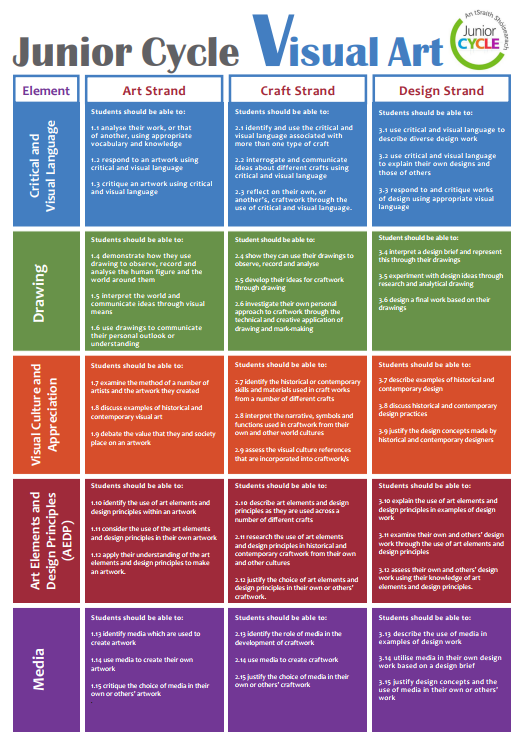Junior Cycle - Visual Art
Visual Art
The junior certificate programme is completely changing, as part of this Art is also changing to reflect a more realistic and connected study of the subjects, that reflects its use in modern society. The subject title is changing from Art, Craft, Design to Visual Art, as this encompasses the modern reality of the subject. It is much more than the mere study of fine Art, craft and design, now it includes video, sound, installation and performance also.
Visual Art has three strands to it; Art, Craft, Design, however along with these strands there are five elements : Critical and visual language, drawing, visual culture and appreciation, art elements and design principles (AEDP) and media.
The assessment of Visual Art (JCPA) will comprise two classroom based assessments (CBA). There is no final examination. The first CBA will take place in second year - process and realisation - Students, either individually or in a group, choose one scenario from a list prepared from a list prepared by the NCCA. This will include Visual Art sketchbook used to generate ideas, experiment and develop these ideas. They will also have to realise an artwork through one of the three strands. The second CBA will take place in third year - presentation - individually, students choose one scenario from a list prepared by the SEC and NCAA. Students will need to generate ideas, experiments and other preparatory work in their visual art sketchpad. Students will then present their initial research and work through the two remaining strands not undertaken as part of the first classroom based assessment.
' Visual Art is ambiguous; there is no single 'correct answer' in Visual Art: The subject promotes divergent thinking and develops the learner's ability to interpret, make judgements and express opinions on a work. It also promotes respect for the work and the opinions of others.
Visual Art is concerned with the personal, cognitive and physical fulfilment of the learner in both the present moment - producing work that gives personal pleasure and reward in the short-term, as well as in preparation for longer-term, more distant goals.
The qualities that Visual Art develops are crucial components of the rounded general education that all young people should experience. These personal characteristics and attributes include creativity, critical judgement, working with others or working individually, providing and receiving constructive criticism, and respecting differences.
Visual Art provides the learner with a space within which it is safe to experiment, to fail and to learn. It allows learners to collaborate on ideas and work. It facilitates and encourages the questions a learner may raise in travelling a path that may not lead to an anticipated outcome or that may produce a different outcome to what was planned. It gives them the capacity to understand and to express ideas, feelings and opinions: both their own and those of others.
Contemporary culture is highly visual. Visual literacy is an essential requirement of active citizenship. It enhances the young person’s ability to interpret, critique and decode visual messages. The capacity to engage in critical thinking in the art class fosters the young person’s competence and confidence in responding to and engaging with the visual culture of the contemporary world and with the natural and built environments. It opens their minds to the traditions and values of other cultures and influences. Visual literacy and the ability to appreciate visual culture adds to the wealth of learning available through historical artefact's and to an understanding of the evolution of works of art, craft or design across the development of human society.
In Visual Art, students build on the progress and skills they have already achieved in primary school in order to help them further improve. Students of the subject will develop the transversal skills, such as creativity, collaboration, ability to question, risk- assessment , problem identification, problem-solving and management of their own emotions; skills that form a natural learning mechanism that can enhance their own development. Students learn how best to use traditional and contemporary technologies for both creative and operational purposes. All these skills and dispositions are key to future learning in senior cycle, higher education, and also in the world of work.' (NCCA)


Comments
Post a Comment